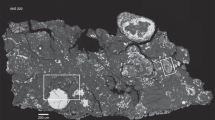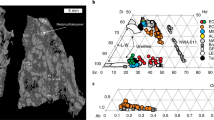Abstract
CARBONACEOUS chondrites contain approximately solar abundances of the non-volatile elements1, but are much more FeO-rich2 than upper mantle peridotites3 or hypothetical 'chondritic' mantle compositions4,5. If the Earth accreted from unfractionated, primitive meteoritic debris similar to the carbonaceous chondrites, how then did it become a fractionated, layered body with a crust, mantle and core? Here I report the results of high-pressure melting experiments on the Allende CV3 carbonaceous chondrite, which address this question and provide a new look at the Earth's earliest stage of differentiation. Multi-anvil experiments at 24, 26 and 26.5 GPa show that FeO-rich magnesiowüstite is an abundant crystallizing phase at temperatures near the Allende silicate liquidus. If a chondritic Earth experienced a high-temperature molten stage, then during cooling and crystallization, FeO-rich magnesiowüstite could be segregated to the deepest levels of the Earth's interior. Magnesiowüstite fractionation may thus have depleted the initial FeO content of the primitive chondritic mantle and contributed to the formation and growth of the Earth's core.
This is a preview of subscription content, access via your institution
Access options
Subscribe to this journal
Receive 51 print issues and online access
$199.00 per year
only $3.90 per issue
Buy this article
- Purchase on Springer Link
- Instant access to full article PDF
Prices may be subject to local taxes which are calculated during checkout
Similar content being viewed by others
References
Anders, E. & Grevesse, N. Geochim. cosmochim. Acta 53, 197–124 (1989).
Jarosewich, E., Clarke, R. S. Jr & Barrows, J. N. (eds) Smithsonian Centr. Earth Sci. 27 (1987).
Jagoutz, E. et al. Proc. lunar planet. Sci. Conf. 10, 2031–2050 (1979).
Anderson, D. L. & Bass, J. D. Nature 320, 321–328 (1986).
Ohtani, E., Kato, T. & Sawamoto, H. Nature 322, 352–353 (1986).
Williams, Q. Geophys. Res. Lett. 17, 635–638 (1990).
Jeanloz, R. & Thompson, A. B. Rev. Geophys. Space Phys. 21, 51–74 (1983).
Urakawa, S., Kato, M. & Kumazawa, M. in High-Pressure Research in Mineral Physics (eds Manghnani, M. H. & Syono, Y.) 95–111 (Terra Scientific, Tokyo, 1987).
Jeanloz, R. & Ahrens, T. J. Geophys. J. R. astr. Soc. 62, 505–528 (1980).
Knittle, E. & Jeanloz, R. Geophys. Res. Lett. 8, 1541–1544 (1986).
Ohtani, E., Ringwood, A. E. & Hibberson, W. Earth planet. Sci. Lett. 71, 94–103 (1984).
Kato, T. & Ringwood, A. E. Phys. Chem. Miner. 16, 524–538 (1989).
Knittle, E. & Jeanloz, R. Geophys. Res. Lett. 16, 609–612 (1989).
Uto, E. & Takahashi, E. Nature 328, 514–517 (1987).
Ohtani, E. & Sawamoto, H. Geophys. Res. Lett. 14, 733–736 (1987).
Jeanloz, R. & Knittle, E. Phil. Trans. R. Soc. A328, 377–389 (1989).
Agee, C. B. & Walker, D. J. geophys. Res. 93, 3437–3449 (1988).
Agee, C. B. Eos 70, 1418 (abstr.) (1989).
Rigden, S. M., Ahrens, T. J. & Stolper, E. M. Science 226, 1071–1074 (1984).
Rigden, S. M., Ahrens, T. J. & Stolper, E. M. J. geophys. Res. 94, 9508–9522 (1989).
Miller, G. H., Stolper, E. M. & Ahrens, T. J. J. geophys. Res. (in the press).
Birch, F. J. geophys. Res. 69, 4377–4388 (1964).
Ringwood, A. E. Origin of the Earth and the Moon (Springer-Verlag, New York, 1979).
Wanke, H., Dreibus, G. & Jagoutz, E. in Archean Geochemistry (eds Kröner, A., Hanson, G. N. & Goodwin, A. W.) 1–24 (Springer-Verlag, Berlin, 1984).
O'Neill, H. St C. Geochim. cosmochim. Acta (in the press).
Agee, C. B. & Walker, D. Earth planet. Sci. Lett. 90, 144–156 (1988).
Jephcoat, A. & Olson, P. Nature 325, 332–335 (1987).
Sawamoto, H. in High-Pressure Research in Mineral Physics (eds Manghnani, M. H. & Syono, Y.), 209–219 (Terra Scientific, Tokyo, 1987).
Ito, E. & Takahashi, E. J. geophys. Res. 94, 10637–10646 (1989).
Katsura, T. & Ito, E. Institute for Study of the Earth's Interior, Tech. Rep. 16, Ser. A (1988).
Benz, W., Cameron, A. G. W. & Melosh, H. J. Icarus 81, (1989).
O'Hara, M. J., Saunders, M. J. & Mercy, E. L. P. Phys. Chem. Earth 9, 571–604 (1975).
Author information
Authors and Affiliations
Rights and permissions
About this article
Cite this article
Agee, C. A new look at differentiation of the Earth from melting experiments on the Allende meteorite. Nature 346, 834–837 (1990). https://doi.org/10.1038/346834a0
Received:
Accepted:
Issue Date:
DOI: https://doi.org/10.1038/346834a0
This article is cited by
-
Geochemical models of core–mantle differentiation
Acta Geochimica (2022)
-
Timescale of open-reservoir evolution beneath the south Cleft segment, Juan de Fuca ridge
Mineralogy and Petrology (2012)
-
Compositional effects on element partitioning between Mg-silicate perovskite and silicate melts
Contributions to Mineralogy and Petrology (2005)
-
Prediction of crystal–melt partition coefficients from elastic moduli
Nature (1994)
Comments
By submitting a comment you agree to abide by our Terms and Community Guidelines. If you find something abusive or that does not comply with our terms or guidelines please flag it as inappropriate.



